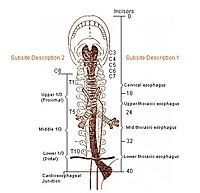
Photo from wikipedia
Background: The term “acute esophageal mucosal lesion (AEML)” includes black esophagitis, and non-black esophagitis characterized by diffuse circumferential erosions without black-appearing mucosa. Black esophagitis is easily diagnosed, whereas non-black esophagitis… Click to show full abstract
Background: The term “acute esophageal mucosal lesion (AEML)” includes black esophagitis, and non-black esophagitis characterized by diffuse circumferential erosions without black-appearing mucosa. Black esophagitis is easily diagnosed, whereas non-black esophagitis is often misdiagnosed as severe reflux esophagitis (sRE). The aim of this study was to determine differences in clinical characteristics of patients with AEML and those with sRE. Methods: Thirty-nine patients with sRE and 32 patients with AEML were diagnosed on the basis of endoscopic findings from 2009 to 2016. Characteristics assessed included age, sex, medication use, coexisting endoscopic finding, comorbidities, laboratory tests results, and chief complaints. Results: In contrast with sRE, male sex, need for emergency endoscopy, presence of duodenal lesions, hypertension, and renal dysfunction were positively associated with AEML. Analysis of associations between laboratory data and AEML showed that high white blood cell count, blood urea nitrogen, and blood glucose were significantly associated with an increase OR for AEML. Conclusions: We showed that AEML differed from sRE regarding both endoscopic findings and clinicopathological features. AEML has not been widely recognized, but it should be defined as a distinct inflammatory disease of the esophagus consisting of both black and non-black esophagitis.
Journal Title: Digestion
Year Published: 2018
Link to full text (if available)
Share on Social Media: Sign Up to like & get
recommendations!